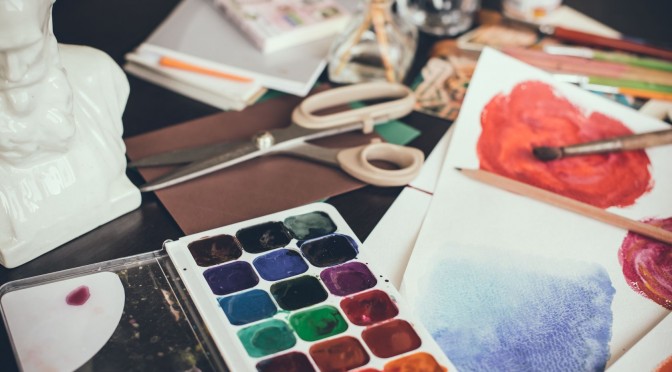Aloha, I’m Kathy. If you’re new to watercolor, it’s important to know that using the right tools is essential for good results. So, let’s jump right in.
Brushes
A good watercolor brush’s job is to hold and release water (and of course, the paint).
There are so many different types of watercolor brushes (see links below), but for the beginner, I am making suggestions based on the easiest and quickest way to get started.
Shape
Again, there are many different shapes of watercolor brushes, the most common starter brushes are rounds and flats.
- Rounds Rounds are the most common shape used by watercolorists because they are very versatile. The round, pointed shape allows you to paint small details as well as broader strokes and washes.
- Flats Flat brushes are useful for painting washes and strong, straight strokes
Hair
You should know that there are two basic hair types. Natural hair and synthetic.
- Natural The hair in natural hair brushes comes from a variety of animals: sable, squirrel, ox, goat, etc. No animals are destroyed for the purpose of brush making.
Natural Hair brushes have superior paint-holding ability because of the tiny, microscopic “scales” along the shaft of the hair. Shorter-length hair is more readily available, making the longer lengths more expensive. Natural hair may be used alone (pure) or blended with other hairs or synthetic filaments to achieve a combination of performance and price.
- Synthetic Synthetic brushes are man-made of either nylon or polyester filaments. The advantages of synthetics include:
- They are less prone to damage from solvents and paints
- They are easier to keep clean than animal hair
- They are less prone to breakage and are durable on many different surfaces
The key points are that natural brushes hold a lot more paint and water but tend to become worn with use. The synthetic brushes are usually less expensive, tend to hold their shape longer, but do not hold as much paint or distribute it as evenly as natural hairs.
My suggestion would be to start with a few round brushes for the detail work and a couple of flat brushes for the washes.
Rounds-8, 10, 12, 20
Flats-1/2 inch, 1 inch
Quality is important, and since the natural hair brushes are the most expensive you can look for some of the very good synthetic blends that are available.
Useful Brush Links
www.art-is-fun.com/paintbrushes-for-watercolors
www.dickblick.com/info/brushpdf/brushshapes.pdf
Paints
Watercolor paints come in 2 different grades: artist quality and student quality. As with most everything, you get what you pay for. Even though student quality is more affordable, the paint has less pigment and more fillers. Artist quality paints will provide you with richer color and more variations.
Brands
As for brands, this really is a matter of personal preference, I will list a few brands only, as well as some links to artist’s opinions.
www.wetcanvas.com/forums/showthread
Brands I have used:
- Winsor & Newton
- Holbein
- M. Graham
Colors
Again, there are a lot of different opinions here.
www.wetcanvas.com/forums/showthread
I have found that the best way to start with color is to start with cools and warms of the basic primary colors: Red, Blue, Yellow. From there you can mix your own colors and will have richer results than if you bought a pre-mixed color. So, start with two of each of the primaries (these are JUST examples):
Warm
- Red: Scarlet Lake
- Blue: Ultramarine Blue
- Yellow: New Gamboge
Cool
- Red: Alizarin Crimson
- Blue: Cerulean Blue
- Yellow: Lemon Yellow
Paper
One of the most important elements of successful watercolor painting is the quality of the paper.
You can buy individual sheets of paper, pads, or blocks in different weights and textures.
- A full sheet is 22″ x 30″
- Pads are usually 9″ x 12″ or 10″ x 14″
Weight
The most commonly used weights are 140lb and 300lb; the higher the number, the thicker the paper.
Texture
warm press-Slick surface, colors appear brighter, easier to lift off
rough-Textured surface, paint will settle in the wells of the paper
cold press-Texture somewhere between rough and warm press. This is the paper most used by watercolor artists.
I prefer Arches 300lb cold press paper. it does not require stretching or taping to your board because it does not buckle or curl.
It’s all about having fun!
Some of the many artists who have inspired me
www.facebook.com/carmen.gardner.maui
Inspirational Videos
Inspirational Videos:
Ross Barbera
How To Paint the Red Hibiscus Flower In Watercolor I
How To Paint the Red Hibiscus In Watercolor II
How To Paint the Red Hibiscus In Watercolor III
Birgit O’Connor
Watercolor Unleashed: Painting white flowers
Carmen Gardner
Peace!
![KB Pink crystal[1]](https://puamele.com/wp-content/uploads/2015/02/KB-Pink-crystal11-199x300.jpg)
Visit us at: www.Etsy.com

